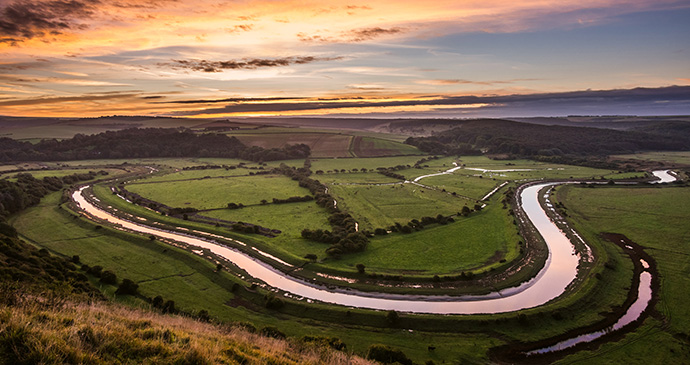
If there’s one place above all that needs to be savoured slowly, this is it – browsing a rockpool at Cuckmere Haven, munching a sandwich and spotting Bronze-Age flints on turf clifftops, or drinking in the view of the wavy profile of the Seven Sisters from Seaford Head.
Sussex’s most sublime stretch of coast is within this small chunk of the South Downs, comprising the cliffs between Seaford and Eastbourne. But it’s a relatively brief affair; if there’s one place above all that needs to be savoured slowly, this is it – browsing a rockpool at Cuckmere Haven, munching a sandwich and spotting Bronze-Age flints on turf clifftops, or drinking in the view of the wavy profile of the Seven Sisters from Seaford Head. Westwards, a huge shingle beach lines the low-lying coast all the way to Newhaven, a clean and inviting sweep of shore that makes one of the best swimming spots hereabouts.
Inland, the Downs have some really quiet moments: even though this is one of the most thoroughly thumbed parts of the national park, there is plenty for escapists. The ever-nasty but useful A27 disappears from view and earshot completely as you ascend into the world of skylarks either side of the Cuckmere Valley near Alfriston; the South Downs Way encounters a primeval moment above the enigmatic Long Man of Wilmington, Britain’s tallest chalk hill figure above the head of Deep Dean, a secretive dry valley unaltered by modern agriculture, its slopes too steep for the plough.
Lewes gets a trickle of canny tourists but apart from the spectacular exception of bonfire night in November is never particularly overrun. Sloping, neighbourly, enticing, nonconformist, ancient, distinctive – it suggests plenty of adjectives. I one favourite landmark view had to be singled out then it is the prospect down School Hill, past Harvey’s Brewery with its periodic malty aroma wafting over passing shoppers, to the Downs above. Art and music are big in the vicinity: many musicians working at Glyndebourne Opera House are based in town or around, and opera-goers often stay over and discover the town’s many pleasures. Lewes also makes an obvious base for those on the trail of Virginia Woolf, who lived nearby at Monk’s House in Rodmell, and her bohemian sister Vanessa Bell and her entourage at Charleston near the estate village of Firle. Anyone keen on the Charleston set should also beat a path to Farley Farm House at Muddles Green for one of the entertaining and erudite Sunday tours of the former house of surrealist painter Roland Penrose and the photographer Lee Miller, where Picasso once visited.